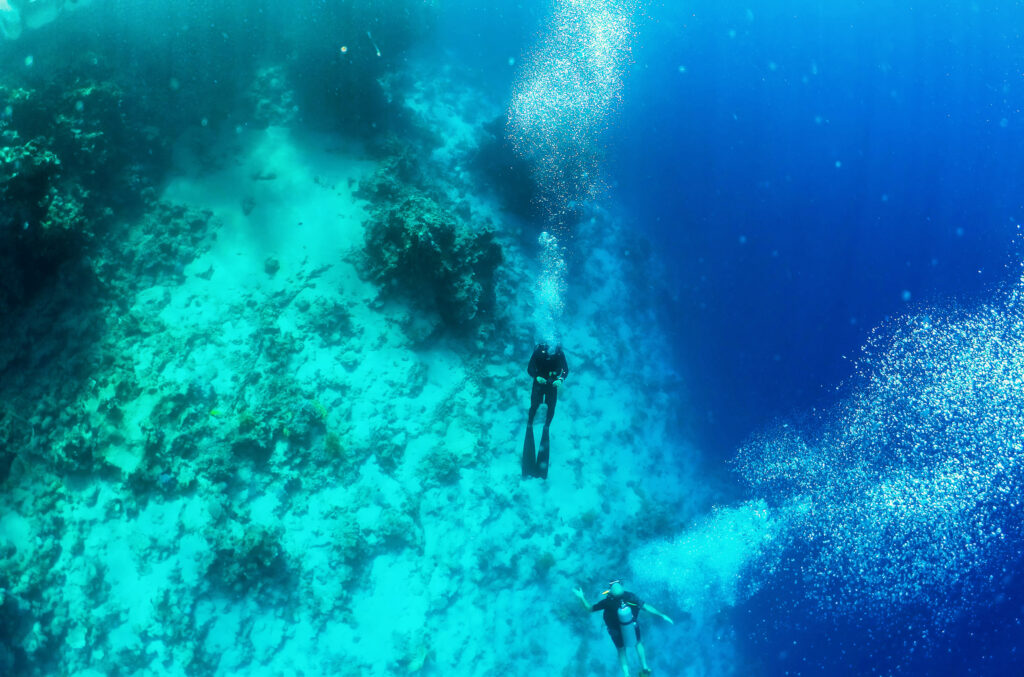What is Partial Pressure?

Partial pressure is a fundamental concept in physics and chemistry, particularly significant in the context of scuba diving. It refers to the pressure exerted by a single type of gas in a mixture of gases. Understanding partial pressure is crucial for divers as it influences how gases are absorbed, transported, and expelled in the human body under varying underwater conditions. This concept helps in comprehending how different gases behave under increased pressures encountered at depth and is essential for ensuring safety and preventing diving-related illnesses.
What is Closed Circuit Scuba?

Closed circuit scuba, commonly referred to as rebreather technology, represents a significant advancement in underwater breathing apparatuses. Unlike traditional open circuit scuba systems, which release exhaled gases into the water, closed circuit rebreathers recycle the diver’s exhaled breath. This recycling process involves scrubbing carbon dioxide from the exhaled air and adding the necessary amount of oxygen to make the gas breathable again. Closed circuit systems are renowned for their efficiency in gas usage, allowing divers to stay underwater for extended periods. These systems are particularly favored in scientific research, military operations, and technical diving, where extended bottom times and reduced gas consumption are crucial.
What is Samba in Scuba Diving?

Samba, in the context of scuba diving, refers to an involuntary muscle spasm or twitching that occurs as a warning sign of impending hypoxia or loss of consciousness underwater. This condition is crucial for divers to recognize because it serves as a precursor to more serious and potentially life-threatening situations such as blackouts. Understanding samba and its implications can significantly enhance diver safety and preparedness, ensuring that appropriate actions are taken promptly to mitigate risks. While samba is less commonly discussed than other diving conditions, its impact on diver health and safety is equally important.
What is Trimix?

Trimix is a specialized breathing gas mixture used by technical divers to safely reach greater depths than what is achievable with air or nitrox. Comprising oxygen, nitrogen, and helium, trimix helps mitigate the risks associated with deep diving, such as nitrogen narcosis and oxygen toxicity. By reducing the proportion of nitrogen and oxygen in the breathing mix, trimix allows divers to explore depths well beyond recreational limits while maintaining a safer physiological profile.
What is Saturation?

Saturation, in the context of scuba diving, refers to the state where body tissues have absorbed the maximum amount of inert gas they can hold at a given pressure. This concept is crucial for divers, especially those engaging in deep or prolonged dives. Understanding saturation helps divers manage their exposure to high-pressure environments and ensures they follow appropriate decompression protocols to avoid decompression sickness (DCS). This article delves into the basic principles of saturation, the specifics of saturation diving, its physiological implications, decompression strategies, technological aspects, and safety protocols.
What is an Electronic Closed Circuit Rebreather?

An electronic closed circuit rebreather (ECCR) is an advanced type of breathing apparatus used in scuba diving. Unlike traditional open-circuit systems, which release exhaled gases into the water, ECCRs recycle the diver’s exhaled breath by removing carbon dioxide and adding oxygen. This sophisticated technology allows divers to maintain optimal gas mixtures at various depths, significantly extending underwater time and reducing the amount of gas needed. ECCRs have become essential in technical, recreational, and military diving, offering enhanced efficiency and safety. Their development marks a significant milestone in underwater exploration, providing divers with unprecedented capabilities.
What is Travel Gas?

Travel gas is a critical component in the world of scuba diving, particularly in the practice of technical diving. This term refers to a specific mixture of gases used by divers to ensure safe and efficient ascents and descents. Unlike recreational diving, which typically involves straightforward gas mixtures like air or enriched air nitrox, technical diving requires more complex planning and gas management. Travel gas plays a vital role in mitigating the risks associated with deep and extended dives, such as decompression sickness and nitrogen narcosis. Understanding its composition, planning, and application is essential for divers aiming to extend their underwater capabilities safely.
What is Nitrogen?

What is Nitrogen? Nitrogen is an inert gas, meaning it does not readily participate in chemical reactions. It constitutes approximately 78% of the Earth’s atmosphere, with the remaining 22% made up of oxygen, trace gases, and water vapor. While nitrogen is essential for various biological processes and is harmless when inhaled at normal atmospheric pressure, […]
What is Residual Gas in Scuba Diving?

What is Residual Gas in Scuba Diving? Residual gas, a significant concept in scuba diving, refers to the volume of gas that remains in a diving cylinder from a previous fill. Understanding and managing residual gas is crucial for divers, as it can have implications for safety, dive planning, and equipment efficiency. Definition and Relevance […]
What is Carbon Dioxide (CO2)?

What is Carbon Dioxide (CO2)? Carbon dioxide (CO2) is an odorless, tasteless gas that is a natural byproduct of metabolism. This greenhouse gas plays a crucial role in the Earth’s atmosphere, and it is also an essential factor to consider for scuba divers. Exhaled by the lungs, CO2 is a critical aspect of scuba diving, […]
